Comprehensive Report: Compliance Management System Analysis
VerifiedAdded on 2021/06/17
|20
|4388
|43
Report
AI Summary
This report provides a detailed analysis of a compliance management system, essential for organizational operations and risk management. It breaks down compliance requirements into internal, external, and industry categories, outlining their significance and impact on various areas such as customer engagement, financial management, employee conduct, and quality assurance. The report identifies potential risks associated with non-compliance, including financial malpractice, lawsuits, and employee demotivation, alongside the penalties involved. It then explores different compliance systems, including audit review, risk management, and quality assurance systems, comparing their cost, effectiveness, efficiency, and feasibility. Furthermore, the report details a research plan, outlining the methodology, timeline, and budget for studying the compliance management system. Finally, it discusses implementation planning, including management information system requirements, key components of a good compliance system, and the importance of management oversight, complaint management, independent auditing, and comprehensive compliance programs to ensure adherence to legal, financial, human resource, and infrastructural standards. The report emphasizes the importance of a synergistic approach to ensure comprehensive compliance.
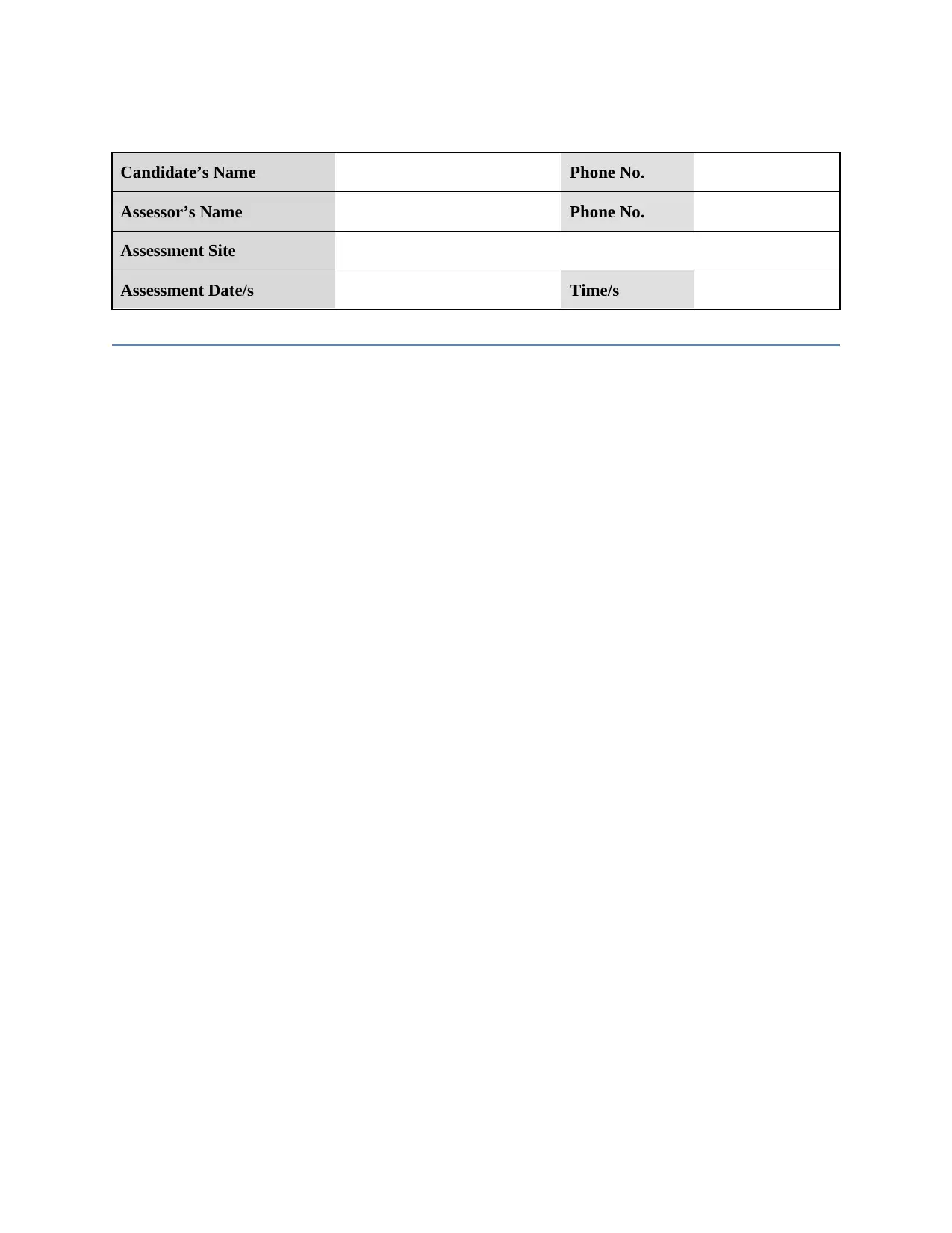
Candidate’s Name Phone No.
Assessor’s Name Phone No.
Assessment Site
Assessment Date/s Time/s
Assessor’s Name Phone No.
Assessment Site
Assessment Date/s Time/s
Paraphrase This Document
Need a fresh take? Get an instant paraphrase of this document with our AI Paraphraser
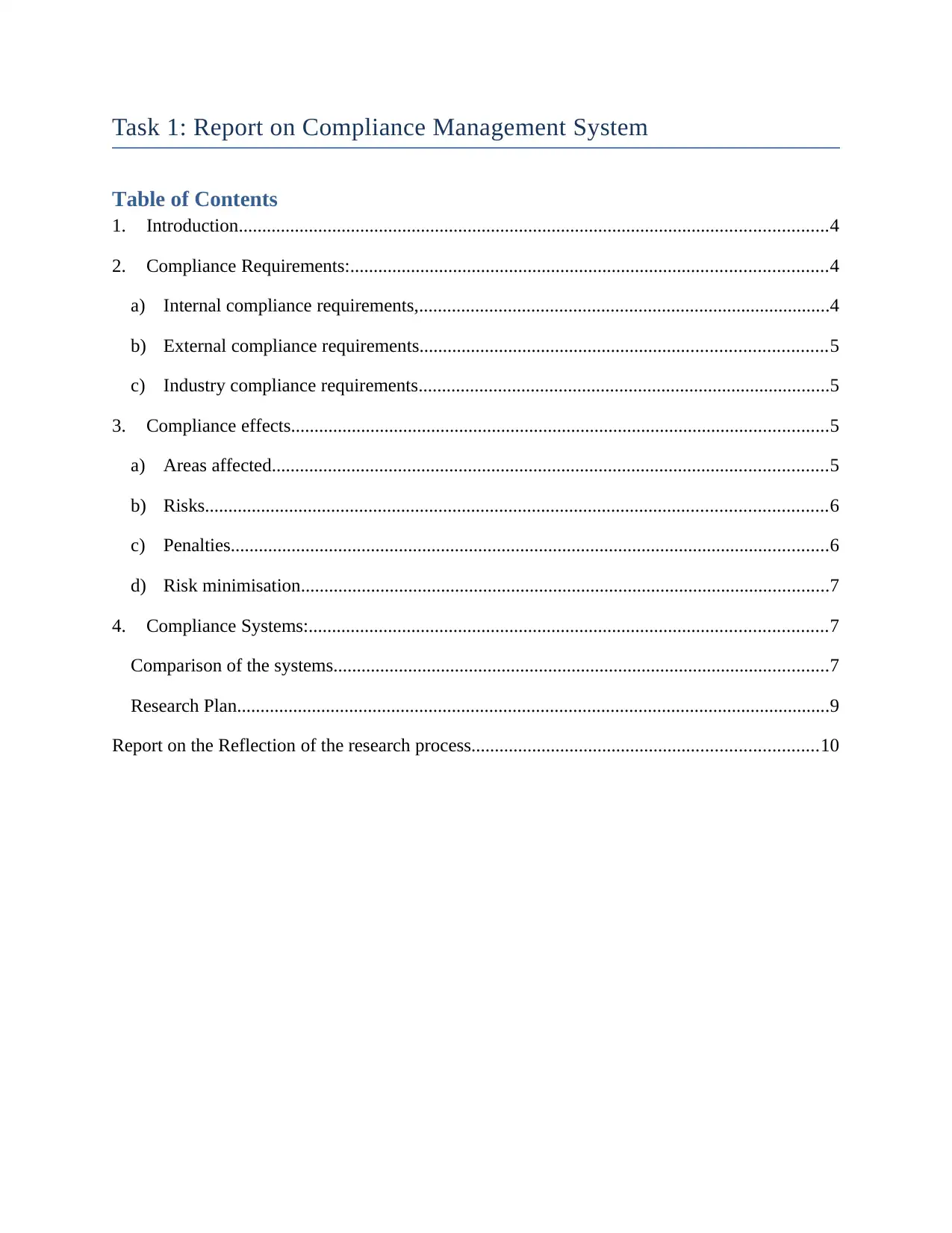
Task 1: Report on Compliance Management System
Table of Contents
1. Introduction..............................................................................................................................4
2. Compliance Requirements:......................................................................................................4
a) Internal compliance requirements,........................................................................................4
b) External compliance requirements.......................................................................................5
c) Industry compliance requirements........................................................................................5
3. Compliance effects...................................................................................................................5
a) Areas affected.......................................................................................................................5
b) Risks.....................................................................................................................................6
c) Penalties................................................................................................................................6
d) Risk minimisation.................................................................................................................7
4. Compliance Systems:...............................................................................................................7
Comparison of the systems..........................................................................................................7
Research Plan...............................................................................................................................9
Report on the Reflection of the research process..........................................................................10
Table of Contents
1. Introduction..............................................................................................................................4
2. Compliance Requirements:......................................................................................................4
a) Internal compliance requirements,........................................................................................4
b) External compliance requirements.......................................................................................5
c) Industry compliance requirements........................................................................................5
3. Compliance effects...................................................................................................................5
a) Areas affected.......................................................................................................................5
b) Risks.....................................................................................................................................6
c) Penalties................................................................................................................................6
d) Risk minimisation.................................................................................................................7
4. Compliance Systems:...............................................................................................................7
Comparison of the systems..........................................................................................................7
Research Plan...............................................................................................................................9
Report on the Reflection of the research process..........................................................................10
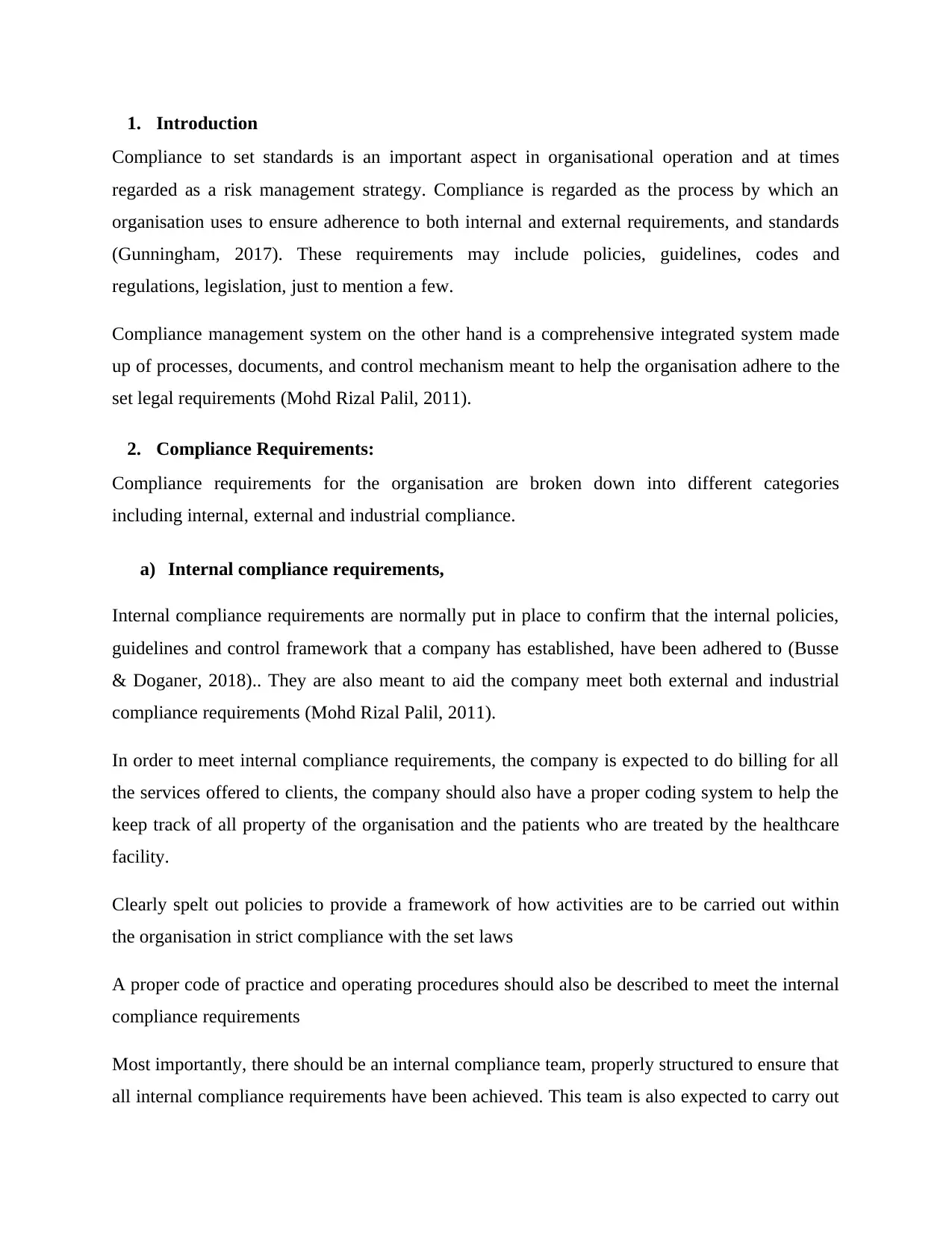
1. Introduction
Compliance to set standards is an important aspect in organisational operation and at times
regarded as a risk management strategy. Compliance is regarded as the process by which an
organisation uses to ensure adherence to both internal and external requirements, and standards
(Gunningham, 2017). These requirements may include policies, guidelines, codes and
regulations, legislation, just to mention a few.
Compliance management system on the other hand is a comprehensive integrated system made
up of processes, documents, and control mechanism meant to help the organisation adhere to the
set legal requirements (Mohd Rizal Palil, 2011).
2. Compliance Requirements:
Compliance requirements for the organisation are broken down into different categories
including internal, external and industrial compliance.
a) Internal compliance requirements,
Internal compliance requirements are normally put in place to confirm that the internal policies,
guidelines and control framework that a company has established, have been adhered to (Busse
& Doganer, 2018).. They are also meant to aid the company meet both external and industrial
compliance requirements (Mohd Rizal Palil, 2011).
In order to meet internal compliance requirements, the company is expected to do billing for all
the services offered to clients, the company should also have a proper coding system to help the
keep track of all property of the organisation and the patients who are treated by the healthcare
facility.
Clearly spelt out policies to provide a framework of how activities are to be carried out within
the organisation in strict compliance with the set laws
A proper code of practice and operating procedures should also be described to meet the internal
compliance requirements
Most importantly, there should be an internal compliance team, properly structured to ensure that
all internal compliance requirements have been achieved. This team is also expected to carry out
Compliance to set standards is an important aspect in organisational operation and at times
regarded as a risk management strategy. Compliance is regarded as the process by which an
organisation uses to ensure adherence to both internal and external requirements, and standards
(Gunningham, 2017). These requirements may include policies, guidelines, codes and
regulations, legislation, just to mention a few.
Compliance management system on the other hand is a comprehensive integrated system made
up of processes, documents, and control mechanism meant to help the organisation adhere to the
set legal requirements (Mohd Rizal Palil, 2011).
2. Compliance Requirements:
Compliance requirements for the organisation are broken down into different categories
including internal, external and industrial compliance.
a) Internal compliance requirements,
Internal compliance requirements are normally put in place to confirm that the internal policies,
guidelines and control framework that a company has established, have been adhered to (Busse
& Doganer, 2018).. They are also meant to aid the company meet both external and industrial
compliance requirements (Mohd Rizal Palil, 2011).
In order to meet internal compliance requirements, the company is expected to do billing for all
the services offered to clients, the company should also have a proper coding system to help the
keep track of all property of the organisation and the patients who are treated by the healthcare
facility.
Clearly spelt out policies to provide a framework of how activities are to be carried out within
the organisation in strict compliance with the set laws
A proper code of practice and operating procedures should also be described to meet the internal
compliance requirements
Most importantly, there should be an internal compliance team, properly structured to ensure that
all internal compliance requirements have been achieved. This team is also expected to carry out
⊘ This is a preview!⊘
Do you want full access?
Subscribe today to unlock all pages.

Trusted by 1+ million students worldwide
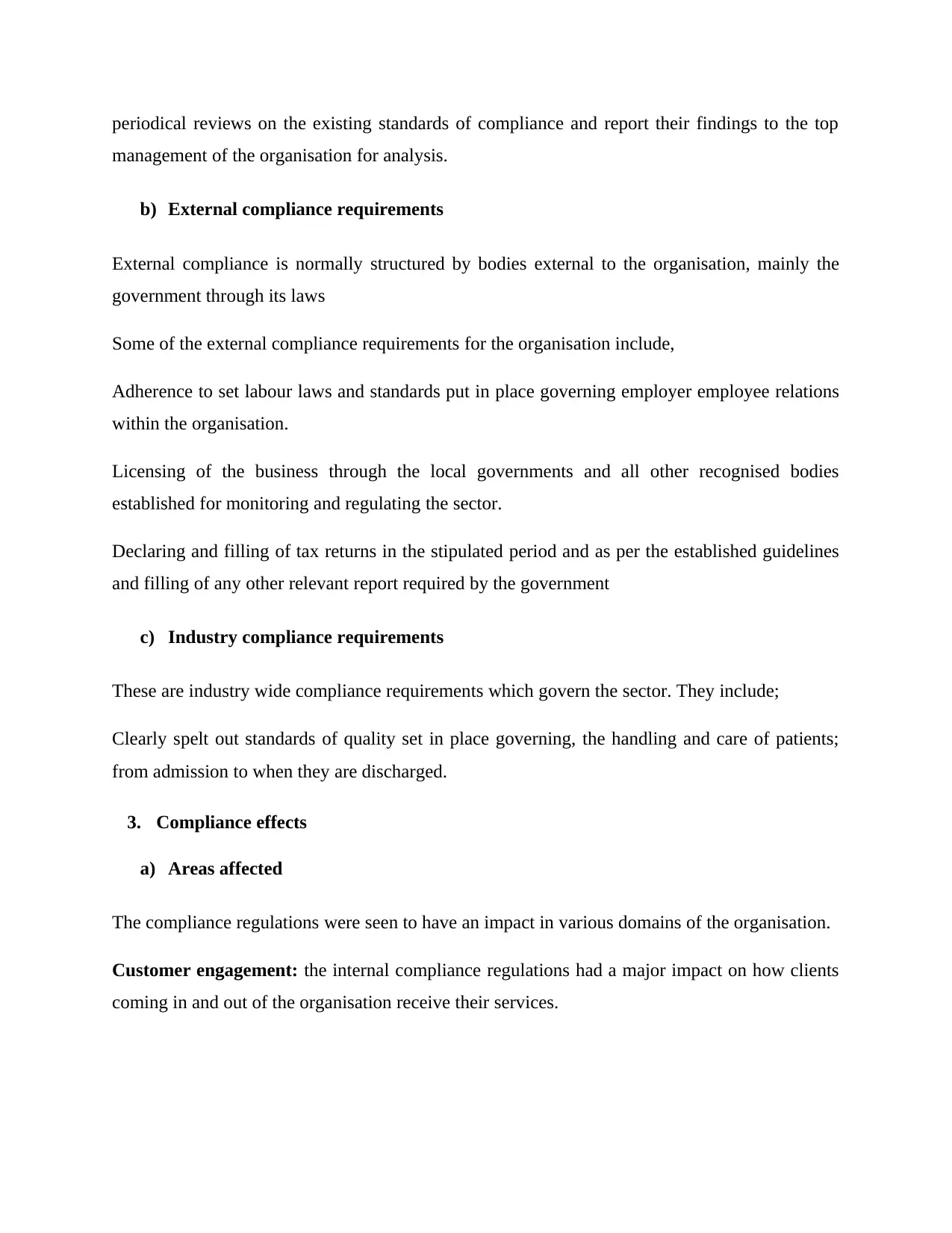
periodical reviews on the existing standards of compliance and report their findings to the top
management of the organisation for analysis.
b) External compliance requirements
External compliance is normally structured by bodies external to the organisation, mainly the
government through its laws
Some of the external compliance requirements for the organisation include,
Adherence to set labour laws and standards put in place governing employer employee relations
within the organisation.
Licensing of the business through the local governments and all other recognised bodies
established for monitoring and regulating the sector.
Declaring and filling of tax returns in the stipulated period and as per the established guidelines
and filling of any other relevant report required by the government
c) Industry compliance requirements
These are industry wide compliance requirements which govern the sector. They include;
Clearly spelt out standards of quality set in place governing, the handling and care of patients;
from admission to when they are discharged.
3. Compliance effects
a) Areas affected
The compliance regulations were seen to have an impact in various domains of the organisation.
Customer engagement: the internal compliance regulations had a major impact on how clients
coming in and out of the organisation receive their services.
management of the organisation for analysis.
b) External compliance requirements
External compliance is normally structured by bodies external to the organisation, mainly the
government through its laws
Some of the external compliance requirements for the organisation include,
Adherence to set labour laws and standards put in place governing employer employee relations
within the organisation.
Licensing of the business through the local governments and all other recognised bodies
established for monitoring and regulating the sector.
Declaring and filling of tax returns in the stipulated period and as per the established guidelines
and filling of any other relevant report required by the government
c) Industry compliance requirements
These are industry wide compliance requirements which govern the sector. They include;
Clearly spelt out standards of quality set in place governing, the handling and care of patients;
from admission to when they are discharged.
3. Compliance effects
a) Areas affected
The compliance regulations were seen to have an impact in various domains of the organisation.
Customer engagement: the internal compliance regulations had a major impact on how clients
coming in and out of the organisation receive their services.
Paraphrase This Document
Need a fresh take? Get an instant paraphrase of this document with our AI Paraphraser
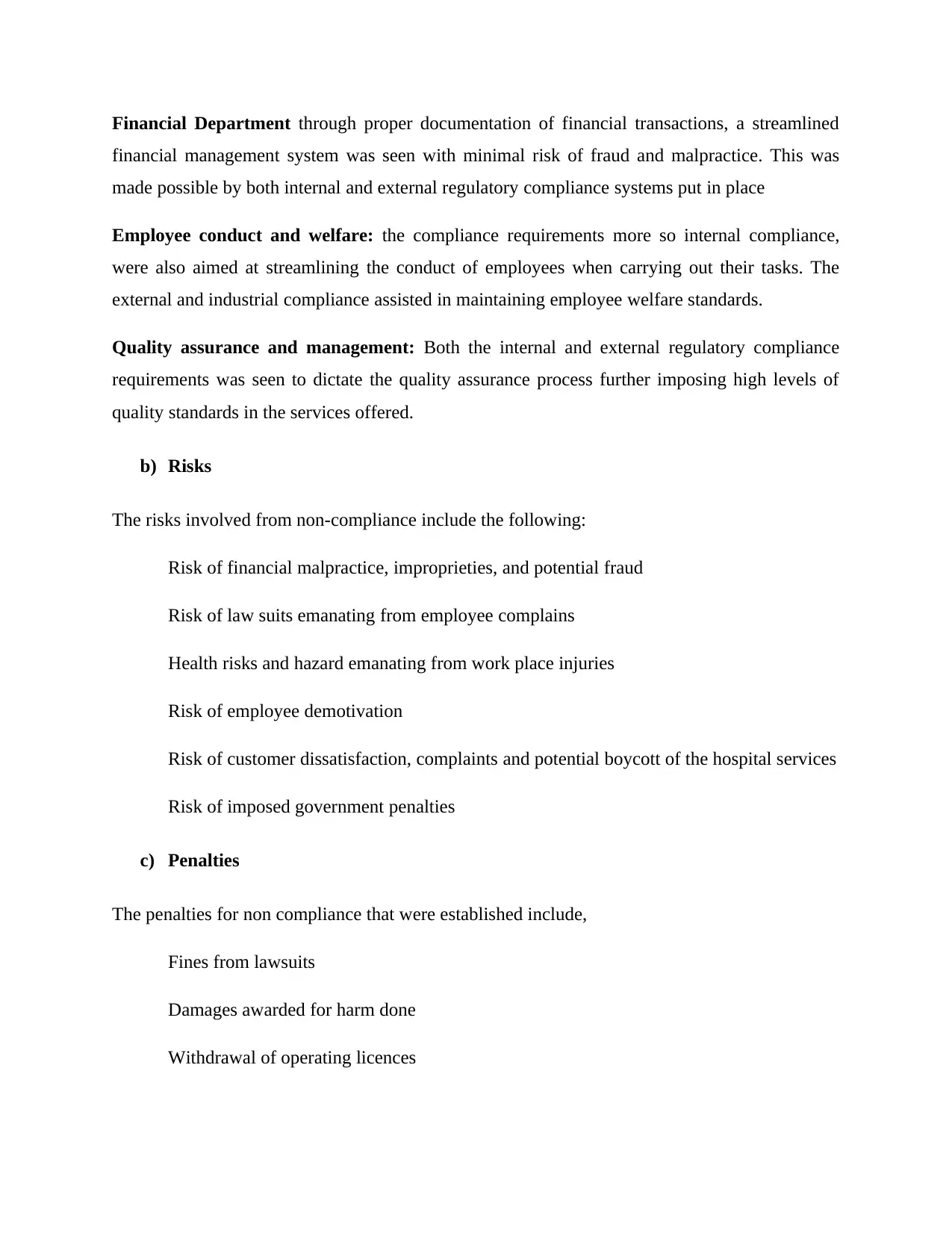
Financial Department through proper documentation of financial transactions, a streamlined
financial management system was seen with minimal risk of fraud and malpractice. This was
made possible by both internal and external regulatory compliance systems put in place
Employee conduct and welfare: the compliance requirements more so internal compliance,
were also aimed at streamlining the conduct of employees when carrying out their tasks. The
external and industrial compliance assisted in maintaining employee welfare standards.
Quality assurance and management: Both the internal and external regulatory compliance
requirements was seen to dictate the quality assurance process further imposing high levels of
quality standards in the services offered.
b) Risks
The risks involved from non-compliance include the following:
Risk of financial malpractice, improprieties, and potential fraud
Risk of law suits emanating from employee complains
Health risks and hazard emanating from work place injuries
Risk of employee demotivation
Risk of customer dissatisfaction, complaints and potential boycott of the hospital services
Risk of imposed government penalties
c) Penalties
The penalties for non compliance that were established include,
Fines from lawsuits
Damages awarded for harm done
Withdrawal of operating licences
financial management system was seen with minimal risk of fraud and malpractice. This was
made possible by both internal and external regulatory compliance systems put in place
Employee conduct and welfare: the compliance requirements more so internal compliance,
were also aimed at streamlining the conduct of employees when carrying out their tasks. The
external and industrial compliance assisted in maintaining employee welfare standards.
Quality assurance and management: Both the internal and external regulatory compliance
requirements was seen to dictate the quality assurance process further imposing high levels of
quality standards in the services offered.
b) Risks
The risks involved from non-compliance include the following:
Risk of financial malpractice, improprieties, and potential fraud
Risk of law suits emanating from employee complains
Health risks and hazard emanating from work place injuries
Risk of employee demotivation
Risk of customer dissatisfaction, complaints and potential boycott of the hospital services
Risk of imposed government penalties
c) Penalties
The penalties for non compliance that were established include,
Fines from lawsuits
Damages awarded for harm done
Withdrawal of operating licences
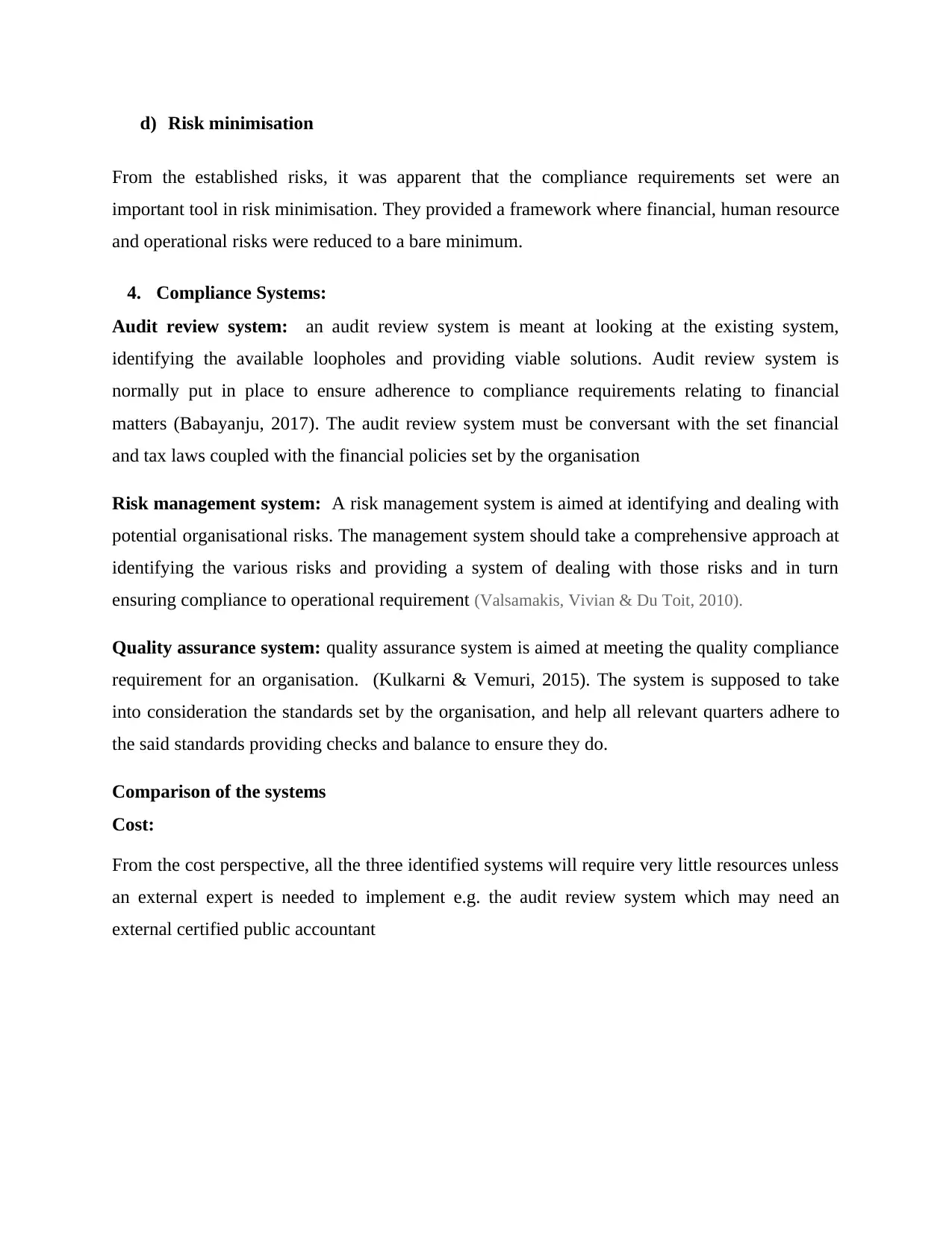
d) Risk minimisation
From the established risks, it was apparent that the compliance requirements set were an
important tool in risk minimisation. They provided a framework where financial, human resource
and operational risks were reduced to a bare minimum.
4. Compliance Systems:
Audit review system: an audit review system is meant at looking at the existing system,
identifying the available loopholes and providing viable solutions. Audit review system is
normally put in place to ensure adherence to compliance requirements relating to financial
matters (Babayanju, 2017). The audit review system must be conversant with the set financial
and tax laws coupled with the financial policies set by the organisation
Risk management system: A risk management system is aimed at identifying and dealing with
potential organisational risks. The management system should take a comprehensive approach at
identifying the various risks and providing a system of dealing with those risks and in turn
ensuring compliance to operational requirement (Valsamakis, Vivian & Du Toit, 2010).
Quality assurance system: quality assurance system is aimed at meeting the quality compliance
requirement for an organisation. (Kulkarni & Vemuri, 2015). The system is supposed to take
into consideration the standards set by the organisation, and help all relevant quarters adhere to
the said standards providing checks and balance to ensure they do.
Comparison of the systems
Cost:
From the cost perspective, all the three identified systems will require very little resources unless
an external expert is needed to implement e.g. the audit review system which may need an
external certified public accountant
From the established risks, it was apparent that the compliance requirements set were an
important tool in risk minimisation. They provided a framework where financial, human resource
and operational risks were reduced to a bare minimum.
4. Compliance Systems:
Audit review system: an audit review system is meant at looking at the existing system,
identifying the available loopholes and providing viable solutions. Audit review system is
normally put in place to ensure adherence to compliance requirements relating to financial
matters (Babayanju, 2017). The audit review system must be conversant with the set financial
and tax laws coupled with the financial policies set by the organisation
Risk management system: A risk management system is aimed at identifying and dealing with
potential organisational risks. The management system should take a comprehensive approach at
identifying the various risks and providing a system of dealing with those risks and in turn
ensuring compliance to operational requirement (Valsamakis, Vivian & Du Toit, 2010).
Quality assurance system: quality assurance system is aimed at meeting the quality compliance
requirement for an organisation. (Kulkarni & Vemuri, 2015). The system is supposed to take
into consideration the standards set by the organisation, and help all relevant quarters adhere to
the said standards providing checks and balance to ensure they do.
Comparison of the systems
Cost:
From the cost perspective, all the three identified systems will require very little resources unless
an external expert is needed to implement e.g. the audit review system which may need an
external certified public accountant
⊘ This is a preview!⊘
Do you want full access?
Subscribe today to unlock all pages.

Trusted by 1+ million students worldwide
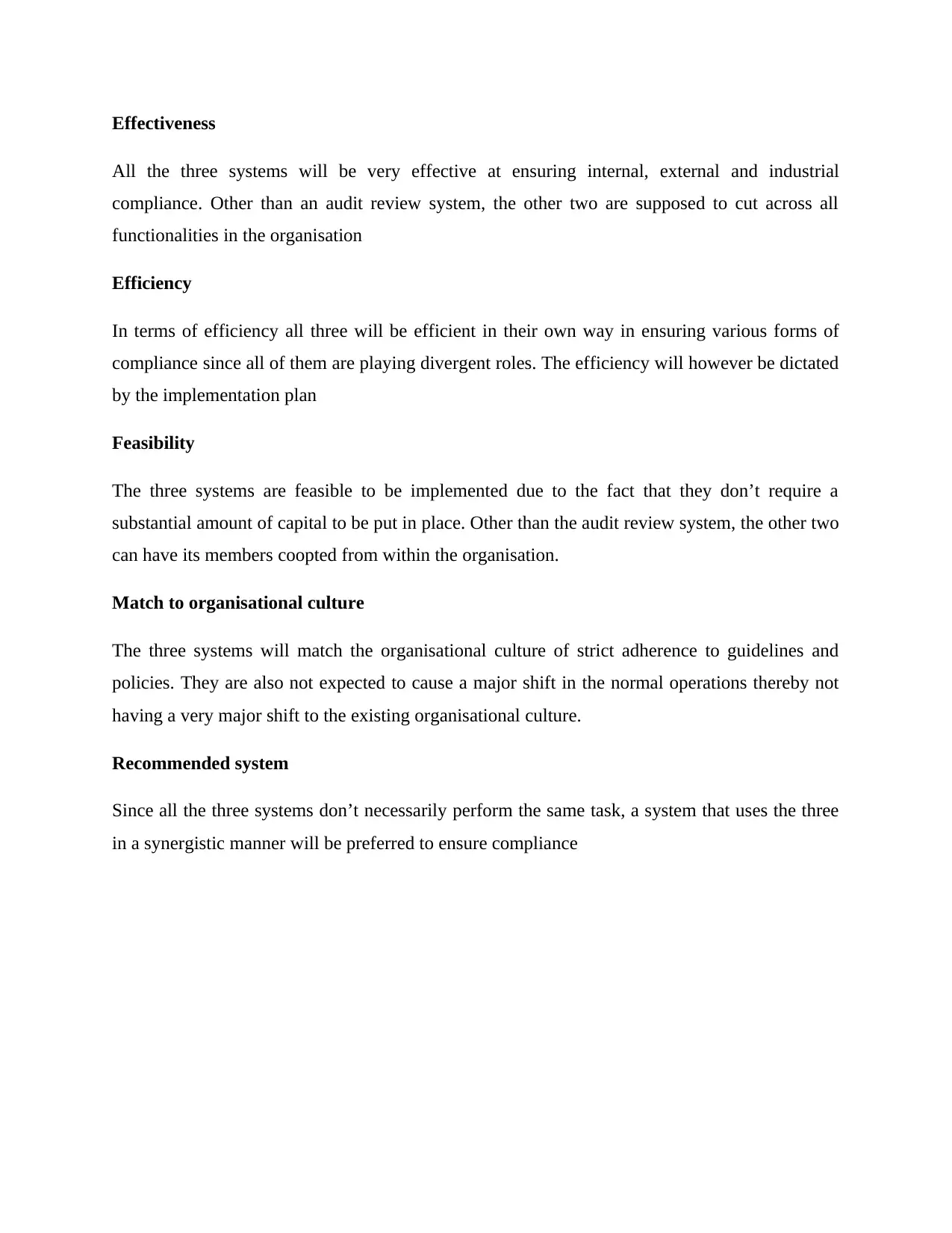
Effectiveness
All the three systems will be very effective at ensuring internal, external and industrial
compliance. Other than an audit review system, the other two are supposed to cut across all
functionalities in the organisation
Efficiency
In terms of efficiency all three will be efficient in their own way in ensuring various forms of
compliance since all of them are playing divergent roles. The efficiency will however be dictated
by the implementation plan
Feasibility
The three systems are feasible to be implemented due to the fact that they don’t require a
substantial amount of capital to be put in place. Other than the audit review system, the other two
can have its members coopted from within the organisation.
Match to organisational culture
The three systems will match the organisational culture of strict adherence to guidelines and
policies. They are also not expected to cause a major shift in the normal operations thereby not
having a very major shift to the existing organisational culture.
Recommended system
Since all the three systems don’t necessarily perform the same task, a system that uses the three
in a synergistic manner will be preferred to ensure compliance
All the three systems will be very effective at ensuring internal, external and industrial
compliance. Other than an audit review system, the other two are supposed to cut across all
functionalities in the organisation
Efficiency
In terms of efficiency all three will be efficient in their own way in ensuring various forms of
compliance since all of them are playing divergent roles. The efficiency will however be dictated
by the implementation plan
Feasibility
The three systems are feasible to be implemented due to the fact that they don’t require a
substantial amount of capital to be put in place. Other than the audit review system, the other two
can have its members coopted from within the organisation.
Match to organisational culture
The three systems will match the organisational culture of strict adherence to guidelines and
policies. They are also not expected to cause a major shift in the normal operations thereby not
having a very major shift to the existing organisational culture.
Recommended system
Since all the three systems don’t necessarily perform the same task, a system that uses the three
in a synergistic manner will be preferred to ensure compliance
Paraphrase This Document
Need a fresh take? Get an instant paraphrase of this document with our AI Paraphraser
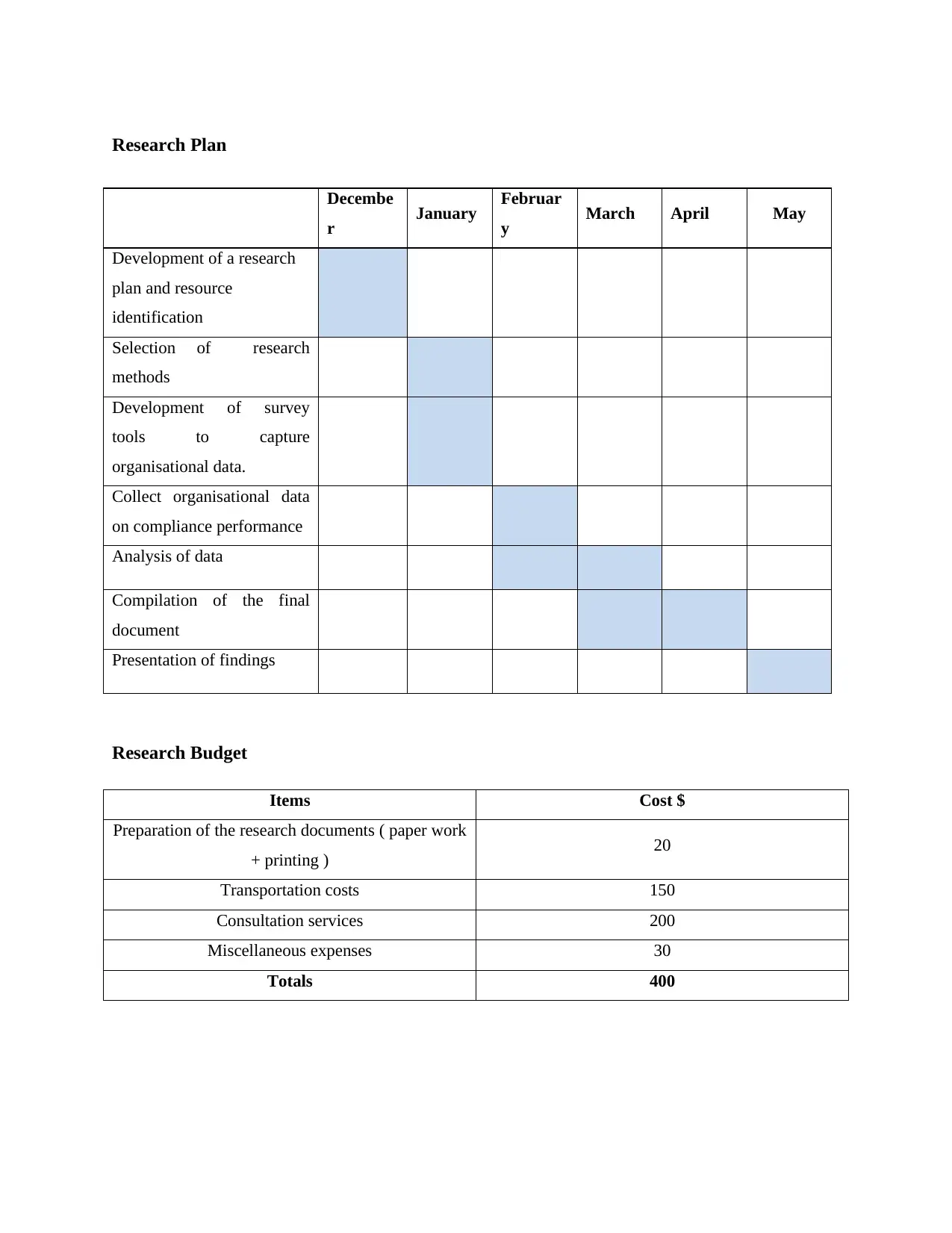
Research Plan
Decembe
r January Februar
y March April May
Development of a research
plan and resource
identification
Selection of research
methods
Development of survey
tools to capture
organisational data.
Collect organisational data
on compliance performance
Analysis of data
Compilation of the final
document
Presentation of findings
Research Budget
Items Cost $
Preparation of the research documents ( paper work
+ printing ) 20
Transportation costs 150
Consultation services 200
Miscellaneous expenses 30
Totals 400
Decembe
r January Februar
y March April May
Development of a research
plan and resource
identification
Selection of research
methods
Development of survey
tools to capture
organisational data.
Collect organisational data
on compliance performance
Analysis of data
Compilation of the final
document
Presentation of findings
Research Budget
Items Cost $
Preparation of the research documents ( paper work
+ printing ) 20
Transportation costs 150
Consultation services 200
Miscellaneous expenses 30
Totals 400
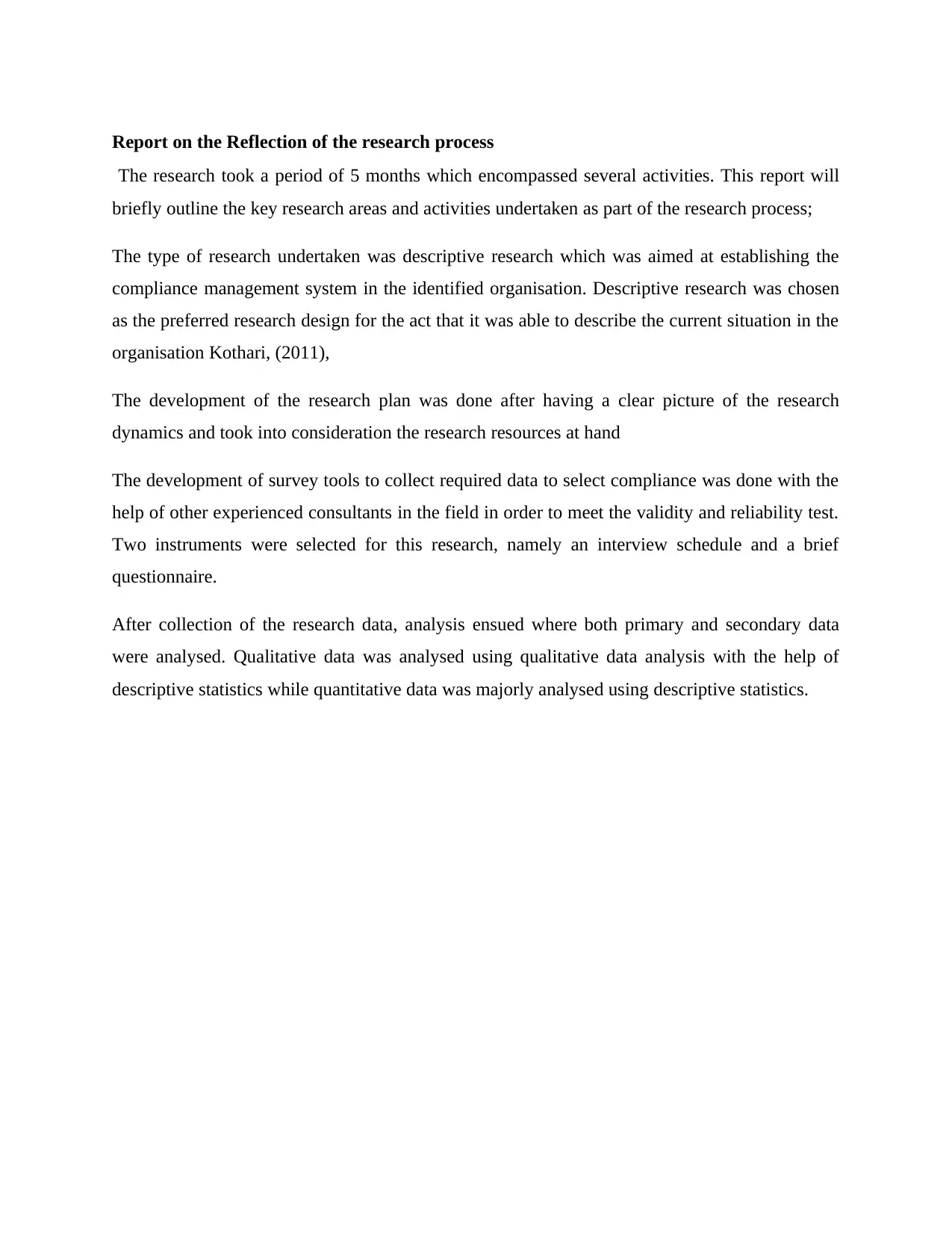
Report on the Reflection of the research process
The research took a period of 5 months which encompassed several activities. This report will
briefly outline the key research areas and activities undertaken as part of the research process;
The type of research undertaken was descriptive research which was aimed at establishing the
compliance management system in the identified organisation. Descriptive research was chosen
as the preferred research design for the act that it was able to describe the current situation in the
organisation Kothari, (2011),
The development of the research plan was done after having a clear picture of the research
dynamics and took into consideration the research resources at hand
The development of survey tools to collect required data to select compliance was done with the
help of other experienced consultants in the field in order to meet the validity and reliability test.
Two instruments were selected for this research, namely an interview schedule and a brief
questionnaire.
After collection of the research data, analysis ensued where both primary and secondary data
were analysed. Qualitative data was analysed using qualitative data analysis with the help of
descriptive statistics while quantitative data was majorly analysed using descriptive statistics.
The research took a period of 5 months which encompassed several activities. This report will
briefly outline the key research areas and activities undertaken as part of the research process;
The type of research undertaken was descriptive research which was aimed at establishing the
compliance management system in the identified organisation. Descriptive research was chosen
as the preferred research design for the act that it was able to describe the current situation in the
organisation Kothari, (2011),
The development of the research plan was done after having a clear picture of the research
dynamics and took into consideration the research resources at hand
The development of survey tools to collect required data to select compliance was done with the
help of other experienced consultants in the field in order to meet the validity and reliability test.
Two instruments were selected for this research, namely an interview schedule and a brief
questionnaire.
After collection of the research data, analysis ensued where both primary and secondary data
were analysed. Qualitative data was analysed using qualitative data analysis with the help of
descriptive statistics while quantitative data was majorly analysed using descriptive statistics.
⊘ This is a preview!⊘
Do you want full access?
Subscribe today to unlock all pages.

Trusted by 1+ million students worldwide
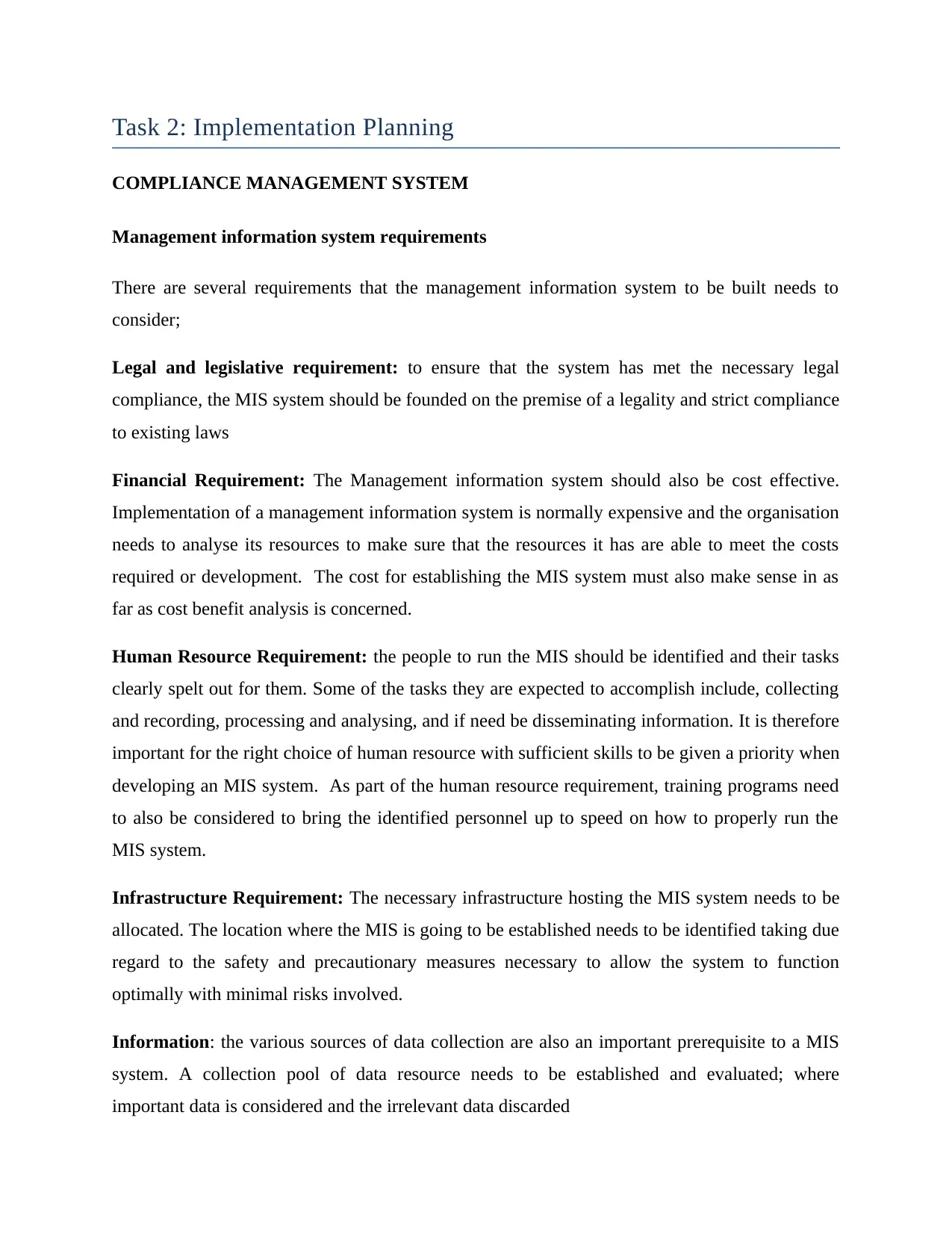
Task 2: Implementation Planning
COMPLIANCE MANAGEMENT SYSTEM
Management information system requirements
There are several requirements that the management information system to be built needs to
consider;
Legal and legislative requirement: to ensure that the system has met the necessary legal
compliance, the MIS system should be founded on the premise of a legality and strict compliance
to existing laws
Financial Requirement: The Management information system should also be cost effective.
Implementation of a management information system is normally expensive and the organisation
needs to analyse its resources to make sure that the resources it has are able to meet the costs
required or development. The cost for establishing the MIS system must also make sense in as
far as cost benefit analysis is concerned.
Human Resource Requirement: the people to run the MIS should be identified and their tasks
clearly spelt out for them. Some of the tasks they are expected to accomplish include, collecting
and recording, processing and analysing, and if need be disseminating information. It is therefore
important for the right choice of human resource with sufficient skills to be given a priority when
developing an MIS system. As part of the human resource requirement, training programs need
to also be considered to bring the identified personnel up to speed on how to properly run the
MIS system.
Infrastructure Requirement: The necessary infrastructure hosting the MIS system needs to be
allocated. The location where the MIS is going to be established needs to be identified taking due
regard to the safety and precautionary measures necessary to allow the system to function
optimally with minimal risks involved.
Information: the various sources of data collection are also an important prerequisite to a MIS
system. A collection pool of data resource needs to be established and evaluated; where
important data is considered and the irrelevant data discarded
COMPLIANCE MANAGEMENT SYSTEM
Management information system requirements
There are several requirements that the management information system to be built needs to
consider;
Legal and legislative requirement: to ensure that the system has met the necessary legal
compliance, the MIS system should be founded on the premise of a legality and strict compliance
to existing laws
Financial Requirement: The Management information system should also be cost effective.
Implementation of a management information system is normally expensive and the organisation
needs to analyse its resources to make sure that the resources it has are able to meet the costs
required or development. The cost for establishing the MIS system must also make sense in as
far as cost benefit analysis is concerned.
Human Resource Requirement: the people to run the MIS should be identified and their tasks
clearly spelt out for them. Some of the tasks they are expected to accomplish include, collecting
and recording, processing and analysing, and if need be disseminating information. It is therefore
important for the right choice of human resource with sufficient skills to be given a priority when
developing an MIS system. As part of the human resource requirement, training programs need
to also be considered to bring the identified personnel up to speed on how to properly run the
MIS system.
Infrastructure Requirement: The necessary infrastructure hosting the MIS system needs to be
allocated. The location where the MIS is going to be established needs to be identified taking due
regard to the safety and precautionary measures necessary to allow the system to function
optimally with minimal risks involved.
Information: the various sources of data collection are also an important prerequisite to a MIS
system. A collection pool of data resource needs to be established and evaluated; where
important data is considered and the irrelevant data discarded
Paraphrase This Document
Need a fresh take? Get an instant paraphrase of this document with our AI Paraphraser
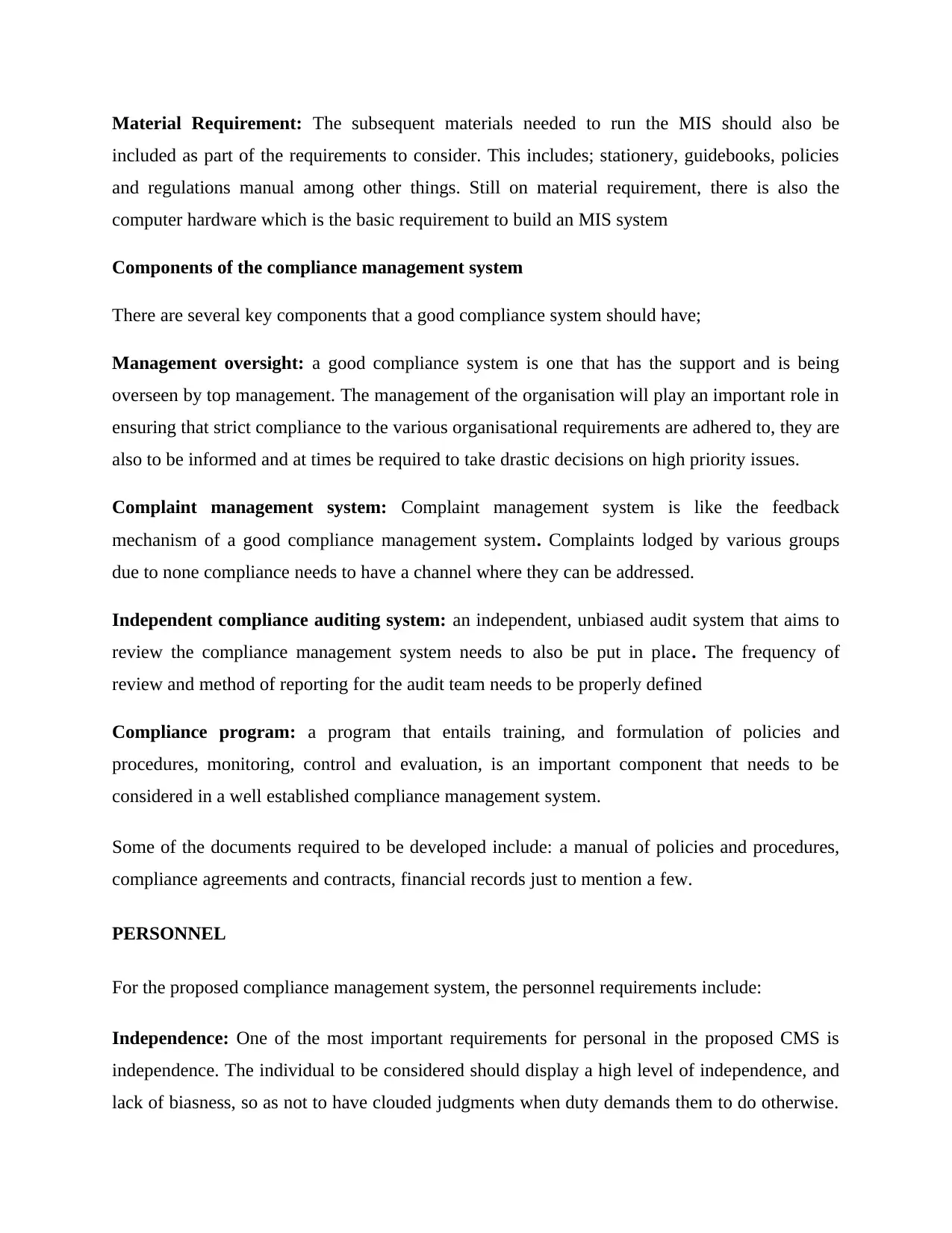
Material Requirement: The subsequent materials needed to run the MIS should also be
included as part of the requirements to consider. This includes; stationery, guidebooks, policies
and regulations manual among other things. Still on material requirement, there is also the
computer hardware which is the basic requirement to build an MIS system
Components of the compliance management system
There are several key components that a good compliance system should have;
Management oversight: a good compliance system is one that has the support and is being
overseen by top management. The management of the organisation will play an important role in
ensuring that strict compliance to the various organisational requirements are adhered to, they are
also to be informed and at times be required to take drastic decisions on high priority issues.
Complaint management system: Complaint management system is like the feedback
mechanism of a good compliance management system. Complaints lodged by various groups
due to none compliance needs to have a channel where they can be addressed.
Independent compliance auditing system: an independent, unbiased audit system that aims to
review the compliance management system needs to also be put in place. The frequency of
review and method of reporting for the audit team needs to be properly defined
Compliance program: a program that entails training, and formulation of policies and
procedures, monitoring, control and evaluation, is an important component that needs to be
considered in a well established compliance management system.
Some of the documents required to be developed include: a manual of policies and procedures,
compliance agreements and contracts, financial records just to mention a few.
PERSONNEL
For the proposed compliance management system, the personnel requirements include:
Independence: One of the most important requirements for personal in the proposed CMS is
independence. The individual to be considered should display a high level of independence, and
lack of biasness, so as not to have clouded judgments when duty demands them to do otherwise.
included as part of the requirements to consider. This includes; stationery, guidebooks, policies
and regulations manual among other things. Still on material requirement, there is also the
computer hardware which is the basic requirement to build an MIS system
Components of the compliance management system
There are several key components that a good compliance system should have;
Management oversight: a good compliance system is one that has the support and is being
overseen by top management. The management of the organisation will play an important role in
ensuring that strict compliance to the various organisational requirements are adhered to, they are
also to be informed and at times be required to take drastic decisions on high priority issues.
Complaint management system: Complaint management system is like the feedback
mechanism of a good compliance management system. Complaints lodged by various groups
due to none compliance needs to have a channel where they can be addressed.
Independent compliance auditing system: an independent, unbiased audit system that aims to
review the compliance management system needs to also be put in place. The frequency of
review and method of reporting for the audit team needs to be properly defined
Compliance program: a program that entails training, and formulation of policies and
procedures, monitoring, control and evaluation, is an important component that needs to be
considered in a well established compliance management system.
Some of the documents required to be developed include: a manual of policies and procedures,
compliance agreements and contracts, financial records just to mention a few.
PERSONNEL
For the proposed compliance management system, the personnel requirements include:
Independence: One of the most important requirements for personal in the proposed CMS is
independence. The individual to be considered should display a high level of independence, and
lack of biasness, so as not to have clouded judgments when duty demands them to do otherwise.
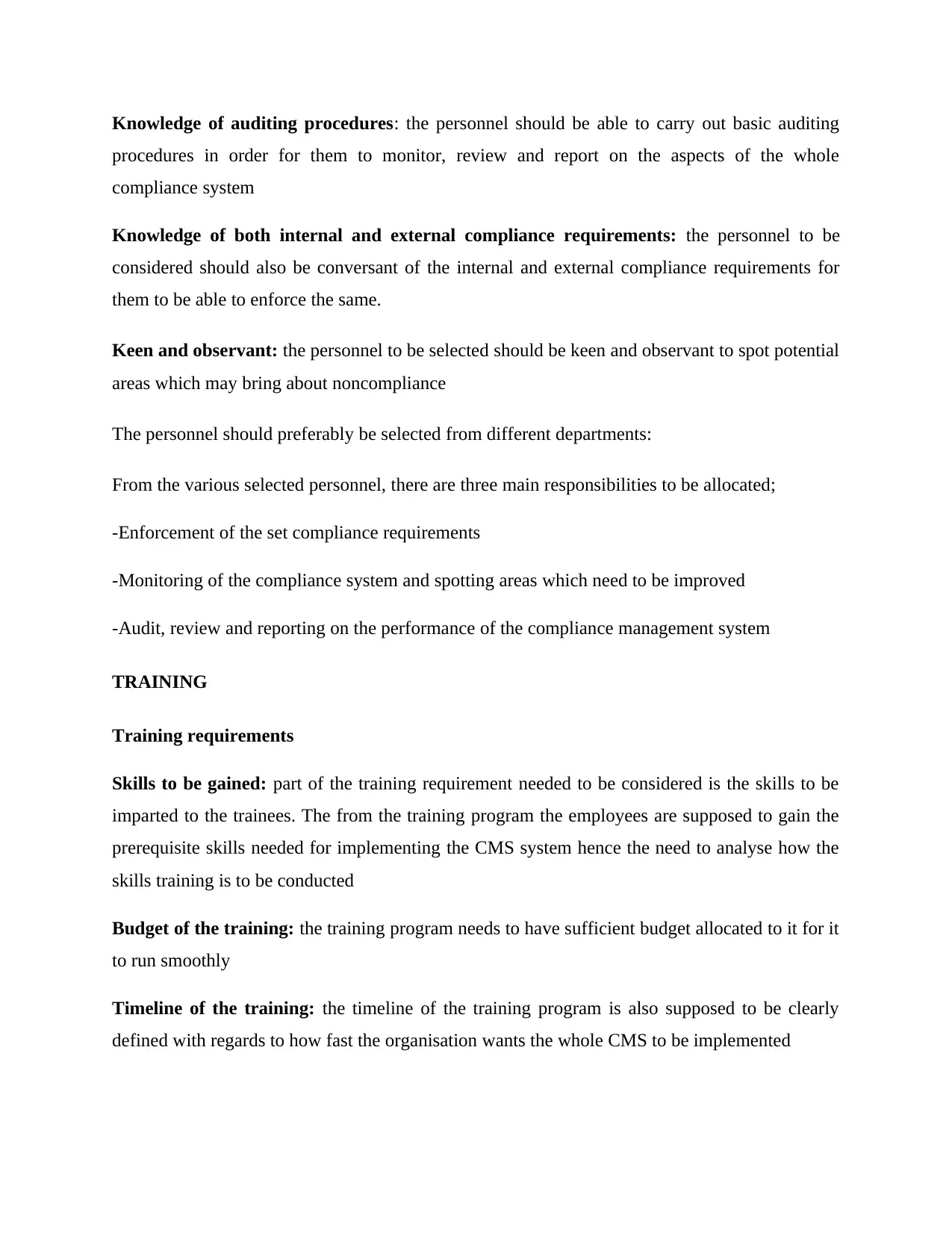
Knowledge of auditing procedures: the personnel should be able to carry out basic auditing
procedures in order for them to monitor, review and report on the aspects of the whole
compliance system
Knowledge of both internal and external compliance requirements: the personnel to be
considered should also be conversant of the internal and external compliance requirements for
them to be able to enforce the same.
Keen and observant: the personnel to be selected should be keen and observant to spot potential
areas which may bring about noncompliance
The personnel should preferably be selected from different departments:
From the various selected personnel, there are three main responsibilities to be allocated;
-Enforcement of the set compliance requirements
-Monitoring of the compliance system and spotting areas which need to be improved
-Audit, review and reporting on the performance of the compliance management system
TRAINING
Training requirements
Skills to be gained: part of the training requirement needed to be considered is the skills to be
imparted to the trainees. The from the training program the employees are supposed to gain the
prerequisite skills needed for implementing the CMS system hence the need to analyse how the
skills training is to be conducted
Budget of the training: the training program needs to have sufficient budget allocated to it for it
to run smoothly
Timeline of the training: the timeline of the training program is also supposed to be clearly
defined with regards to how fast the organisation wants the whole CMS to be implemented
procedures in order for them to monitor, review and report on the aspects of the whole
compliance system
Knowledge of both internal and external compliance requirements: the personnel to be
considered should also be conversant of the internal and external compliance requirements for
them to be able to enforce the same.
Keen and observant: the personnel to be selected should be keen and observant to spot potential
areas which may bring about noncompliance
The personnel should preferably be selected from different departments:
From the various selected personnel, there are three main responsibilities to be allocated;
-Enforcement of the set compliance requirements
-Monitoring of the compliance system and spotting areas which need to be improved
-Audit, review and reporting on the performance of the compliance management system
TRAINING
Training requirements
Skills to be gained: part of the training requirement needed to be considered is the skills to be
imparted to the trainees. The from the training program the employees are supposed to gain the
prerequisite skills needed for implementing the CMS system hence the need to analyse how the
skills training is to be conducted
Budget of the training: the training program needs to have sufficient budget allocated to it for it
to run smoothly
Timeline of the training: the timeline of the training program is also supposed to be clearly
defined with regards to how fast the organisation wants the whole CMS to be implemented
⊘ This is a preview!⊘
Do you want full access?
Subscribe today to unlock all pages.

Trusted by 1+ million students worldwide
1 out of 20
Related Documents
Your All-in-One AI-Powered Toolkit for Academic Success.
+13062052269
info@desklib.com
Available 24*7 on WhatsApp / Email
![[object Object]](/_next/static/media/star-bottom.7253800d.svg)
Unlock your academic potential
Copyright © 2020–2025 A2Z Services. All Rights Reserved. Developed and managed by ZUCOL.





